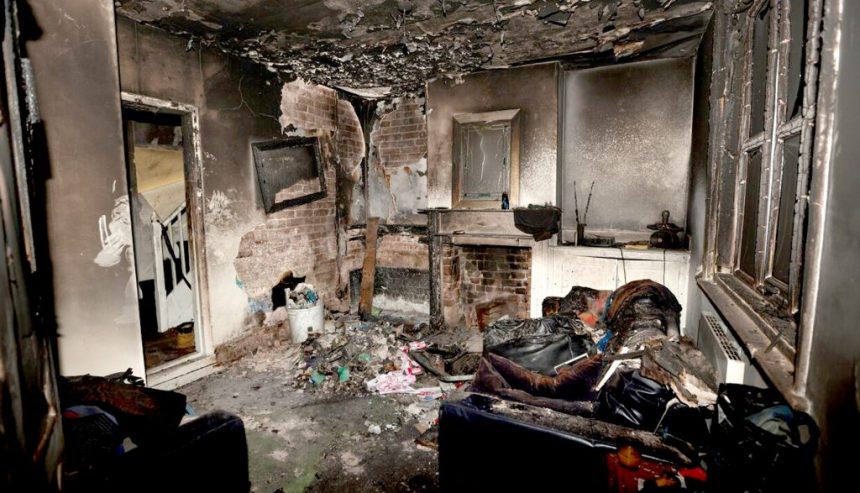A fire can cause more than just visible destruction; it can severely impact the air quality inside your home. Smoke, soot, and toxic chemicals can linger long after the flames are out, creating an unsafe environment for you and your family. Poor indoor air quality (IAQ) due to fire damage can lead to various health risks, making proper restoration crucial.
Understanding Indoor Air Quality (IAQ)
Indoor air quality (IAQ) refers to the air condition inside buildings, affecting occupants’ health and comfort. Good IAQ is essential for breathing easily and avoiding health complications. Fire damage can introduce harmful pollutants that drastically reduce IAQ, making it unsafe to stay indoors without proper remediation.
How Fire Damage Impacts Indoor Air Quality
When a fire breaks out, it releases a mix of harmful substances into the air. These pollutants settle on surfaces, infiltrate ventilation systems, and persist in the environment if not properly addressed.
Smoke and Soot Residue
Smoke from a fire can travel far beyond the affected area, leaving behind soot and residue on walls, furniture, and fabrics. Soot contains microscopic particles that can penetrate deep into the lungs, causing respiratory problems and other health concerns.
Harmful Chemicals Released in a Fire
Fires produce toxic chemicals depending on what materials burn. Some common hazardous substances include:
- Carbon monoxide (CO) – A colorless, odorless gas that can cause headaches, dizziness, and even death in high concentrations.
- Hydrogen cyanide – Released when plastics burn, leading to respiratory distress and neurological damage.
- Formaldehyde – Found in wood and insulation materials, which can cause irritation and long-term health effects.
Odor and Volatile Organic Compounds (VOCs)
One of the most persistent reminders of a fire is the lingering smell of smoke. This is due to volatile organic compounds (VOCs) that get trapped in porous materials like carpets, drywall, and furniture. VOCs contribute to poor IAQ and can cause headaches, nausea, and dizziness.
Health Risks Associated with Fire-Damaged Air
Exposure to fire-related pollutants can have both immediate and long-term health effects.
Short-Term Health Effects
- Eye, nose, and throat irritation
- Coughing and shortness of breath
- Dizziness and headaches
Long-Term Health Concerns
- Increased risk of respiratory diseases
- Cardiovascular complications
- Potential links to cancer due to prolonged exposure to toxic chemicals
Vulnerable Groups at Higher Risk
Certain individuals are more susceptible to the effects of poor IAQ, including:
- Children and elderly individuals
- People with asthma, chronic obstructive pulmonary disease (COPD), or other respiratory conditions

Professional Fire Damage Restoration and IAQ Improvement
Hiring professional restoration specialists is the best way to restore IAQ and ensure a safe living space.
Air Filtration and Ventilation Techniques
Professionals use high-efficiency particulate air (HEPA) filters and air scrubbers to remove airborne contaminants. Negative air pressure systems help prevent cross-contamination during the cleanup process.
Soot and Smoke Removal
Fire restoration teams use deep-cleaning methods to remove soot from walls, ceilings, and HVAC systems. This prevents toxic particles from recirculating in the air.
Deodorization and Air Purification
Techniques such as ozone treatment and hydroxyl generators help eliminate persistent smoke odors, improving IAQ. Cleaning and sealing affected surfaces also prevent odors from resurfacing.
Steps to Take After a Fire to Protect Indoor Air Quality
- Ventilate your home – Open windows and use fans to improve airflow.
- Avoid touching or cleaning soot – This can spread contaminants further.
- Use air purifiers – HEPA air purifiers can help trap harmful particles.
- Hire a professional restoration team – Experts ensure proper cleaning and air purification.
Conclusion
Fire damage doesn’t just leave behind visible destruction—it also compromises indoor air quality, posing serious health risks. Smoke, soot, and toxins can linger for weeks or months if not properly addressed. The best way to restore IAQ is through professional fire damage restoration, ensuring a clean and breathable environment for you and your family.
FAQs
1. How long does it take to restore indoor air quality after a fire?
It depends on the severity of the fire. Professional restoration can take anywhere from a few days to several weeks to completely eliminate contaminants.
2. Can I clean fire damage myself, or should I hire professionals?
Fire damage cleanup requires specialized equipment and expertise. DIY cleaning can spread toxins and worsen air quality, so hiring professionals is highly recommended.
3. What are the best air purifiers for post-fire restoration?
HEPA air purifiers with activated carbon filters are best for removing smoke particles and odors.
4. How can I tell if my home’s air is still contaminated?
Signs include lingering smoke odors, soot buildup, and respiratory symptoms like coughing or irritation. Air quality testing can confirm contamination levels.
5. Does fire damage restoration also help with mold prevention?
Yes. Proper fire damage cleanup removes moisture and contaminants, reducing the risk of mold growth in fire-damaged areas.




 PuroClean Restoration Specialists
PuroClean Restoration Specialists